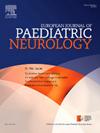Magnetic resonance imaging of masticatory muscles in patients with duchenne muscular dystrophy
IF 2.3
3区 医学
Q3 CLINICAL NEUROLOGY
引用次数: 0
Abstract
Duchenne muscular dystrophy (DMD) is the most common muscular dystrophy in children. Impairment of masticatory function and swallowing disorders, potentially leading to aspiration and gastrostomy, are linked to fatty infiltration in the masticatory muscles, as previously observed in muscle ultrasound. This study aims to quantify muscle volume and fat fraction in muscle magnetic resonance imaging (MRI) in the masticatory muscles in non-ambulant DMD patients compared to healthy controls and evaluate their correlation with maximum bite force (MBF), which has not been previously described. Fifteen patients with DMD and 16 controls were included. MBF was measured with an oral dynamometer and total muscle volume (TMV) and fat signal fraction (FSF) were quantified using MRI with the Dixon technique. Four DMD patients presented with masticatory or swallowing difficulties. DMD patients had a significantly lower median MBF (141.8 N) compared with healthy controls (481.6 N, p < 0.0001). Additionally, median FSF was significantly higher in DMD patients (47.07 %) compared to controls (5.31 %, p < 0.0001). A strong negative correlation between TMV and MBF was observed in DMD patients (ρ = −0.70, p = 0.0048). A significant negative correlation between MBF and normalized FSF was observed in healthy controls (ρ = −0.5487, p = 0.300) and DMD patients (ρ = −0.5893, p = 0.0224). A non-significant positive correlation between age and FSF in DMD was detected (ρ = 0.38, p = 0.17). MBF, TMV and FSF quantified with the Dixon MRI are sensitive measures to evaluate masticatory function in DMD patients and may serve as biomarkers for clinical follow up. Studies in older patients are needed to evaluate the predictive role of MBF, TMV and FSF in the nutritional status of patients and the need for therapeutic interventions such as gastrostomy.
杜氏肌营养不良患者咀嚼肌的磁共振成像
杜氏肌营养不良症(DMD)是儿童中最常见的肌营养不良症。咀嚼功能受损和吞咽障碍可能导致误吸和胃造口术,这与咀嚼肌肉中的脂肪浸润有关,这在以前的肌肉超声中已经观察到。本研究旨在量化非活动DMD患者咀嚼肌的肌肉磁共振成像(MRI)中的肌肉体积和脂肪含量,并评估它们与最大咬力(MBF)的相关性,这在以前没有被描述过。纳入15例DMD患者和16例对照。用口腔测力仪测量MBF,用Dixon技术MRI量化总肌肉体积(TMV)和脂肪信号分数(FSF)。4例DMD患者出现咀嚼或吞咽困难。DMD患者的中位MBF (141.8 N)显著低于健康对照组(481.6 N, p <;0.0001)。此外,DMD患者的FSF中位数(47.07%)显著高于对照组(5.31%,p <;0.0001)。DMD患者TMV与MBF呈显著负相关(ρ = - 0.70, p = 0.0048)。健康对照组(ρ = - 0.5487, p = 0.300)和DMD患者(ρ = - 0.5893, p = 0.0224) MBF与归一化FSF呈显著负相关。DMD患者年龄与FSF呈非显著正相关(ρ = 0.38, p = 0.17)。Dixon MRI量化的MBF、TMV和FSF是评估DMD患者咀嚼功能的敏感指标,可作为临床随访的生物标志物。需要对老年患者进行研究,以评估MBF、TMV和FSF对患者营养状况的预测作用,以及是否需要进行胃造口术等治疗干预。
本文章由计算机程序翻译,如有差异,请以英文原文为准。
求助全文
约1分钟内获得全文
求助全文
来源期刊
CiteScore
6.30
自引率
3.20%
发文量
115
审稿时长
81 days
期刊介绍:
The European Journal of Paediatric Neurology is the Official Journal of the European Paediatric Neurology Society, successor to the long-established European Federation of Child Neurology Societies.
Under the guidance of a prestigious International editorial board, this multi-disciplinary journal publishes exciting clinical and experimental research in this rapidly expanding field. High quality papers written by leading experts encompass all the major diseases including epilepsy, movement disorders, neuromuscular disorders, neurodegenerative disorders and intellectual disability.
Other exciting highlights include articles on brain imaging and neonatal neurology, and the publication of regularly updated tables relating to the main groups of disorders.

 求助内容:
求助内容: 应助结果提醒方式:
应助结果提醒方式:


